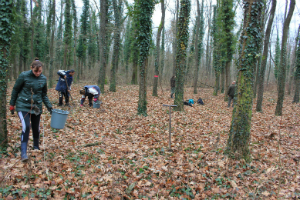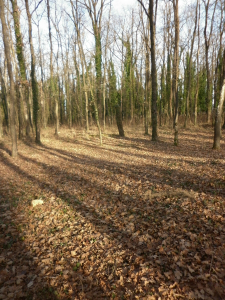Improved conditions in the gallery forests along the Old-Drava

2016-01-22
Renewal of the forest crop began in the floodplain forest along the Old-Drava. In previous years and decades, there were several plantations in the field, however, inappropriate species were planted quiet often. Recent improvement in the water supply to the oxbow will also have positive effects on groundwater levels in the surrounding areas; therefore, it is the right time to make changes to the forest crop in a way that it suits the new conditions better.
15 spots were chosen for the forest renewal; in each 25x25 meters areas were marked. In each area, 50-100 saplings were planted, which were only 30-40 cm in height and not pre-reared. We have chosen species, which have a water demand that fits current and expected conditions in the oxbow. The seedlings were in general not high-growing  species, but native plants that live in the shrub level. Among them we find: Tatar maple (Acer tataricum), European aspen (Populus tremula), European crab apple (Malus sylvestris), European wild pear (Pyrus pyraster) and European spindle (Euonymus europaeus). In the coming years, the priority will be the nursing of the juveniles planted in 2015.
species, but native plants that live in the shrub level. Among them we find: Tatar maple (Acer tataricum), European aspen (Populus tremula), European crab apple (Malus sylvestris), European wild pear (Pyrus pyraster) and European spindle (Euonymus europaeus). In the coming years, the priority will be the nursing of the juveniles planted in 2015.
When selecting the areas, we kept the terrain of the bank of the Old-Drava in mind. The oxbow’s shore has a number of higher areas where there is gravel layer underneath and where groundwater level changes very quickly. Under these higher grounds, water level drops dramatically in dry periods causing difficulties for the plant cover. The state of the current forests also shows signs of these, as dehydration are common in the  ill-selected forests on the higher grounds.
ill-selected forests on the higher grounds.
This situation can be improved by the gradual change and renewal of the forests by the plantation of species that are appropriate for the conditions heavily influenced by changes in groundwater level and soil characteristics. This work has been currently ongoing at the Old-Drava. The selected areas are not directly on the waterfront. The proper management of these forests and their appropriate species composition has visible advantages not only for the state of the forests, but also for the state of the dead tree crop, the nesting and feeding bird population and the insect population. In this respect, forests managed in accordance with local natural conditions are much richer and more diverse.